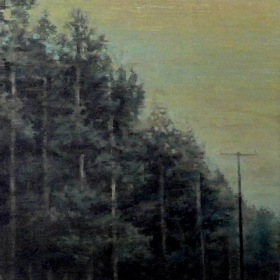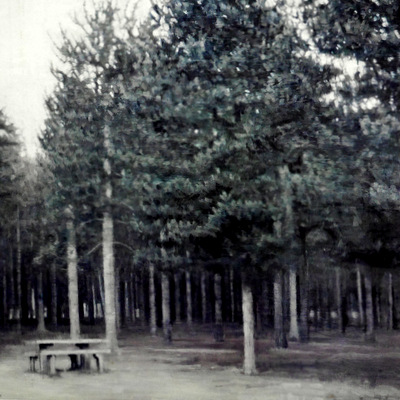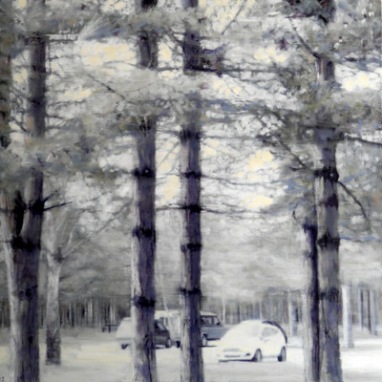KATE SHERMAN: Rendlesham – New Paintings
Onca Gallery, Brighton (5-13 November 2016)
Despite rumours of a UFO incident in 1980, from the evidence of Kate Sherman’s recent paintings, Rendlesham Forest in Suffolk retains a human characteristic: albeit deadpan, but with a fascinating personality that is revealed subtlety if you look long enough. Sherman has worked on this ‘portrait of a forest’ project for two years and the results are impressive.

A quick scan of the display at the ONCA gallery, before a slower and more contemplative viewing, establishes the solemn, greenish-grey and essentially ordered nature of the modern forest site. Representative of this almost detached and nonchalant form of representation is, ‘Rendlesham 8’, which might remind us of John Constable’s, ‘Cenotaph to the Memory of Sir Joshua Reynolds’ (1833-6) or Paul Cézanne’s, ‘Avenue at Chantilly’ (1888), both of which can be seen in the National Gallery, London. In Sherman’s painting, a manmade pathway wide enough for a Forestry Commission tractor, leads the eye to a fuzzy portal, where space is occluded just before mid-distance. Initially, the subject seems obscure.
But if Constable was paying homage to the first President of the Royal Academy; whilst Cézanne explored the possibilities of rendering a subjective experience of landscape, objectively on to a flat surface; Sherman, it seems, contrasts an arguably outmoded Romantic subject matter with an instantaneous, and digital, sampling of the countryside that we might be passing rather than entering.
This dialectical proposition signifies the economically efficient arcadia that society strives for, whilst encoding environmental concerns that grate with a sense of foreboding and loss. Or, as a statement on Sherman’s website explains: “This photographic source is important because the paintings capture a reflective notion of memory, of the emotional distance between a real landscape and a photograph, between experience and longing.”

The deliberate transcription from photographic sources is strongly maintained in this body of work, and emphasises a certain distance from a more personally adoring, singular and emotional interpretation of landscape. Presciently, in many of the images in the show, the original photographic source is cropped at the bottom edge, or the viewfinder is raised above the immediate foreground, to cut the base of the trees from the land. Also, referencing the photographic, or more pertinently today, the digital is significant to what we might accept as the interface with the way we record and view the ‘natural’ environment. On a day-trip to the countryside most of us will frame the view through our iPhone or some lesser equivalent – and this may be enough to satisfy the peculiar need to record places we may otherwise forget.
Kate Sherman, however, has taken the time to carefully select and render such views in paint, offering a far more reflective and substantial experience than the snapshot. In her paintings, the compositions, influenced via the framing devise (a Panasonic DMC-GF6 to be precise), are pervasively structured to repeat how the camera ‘sees’. The subject matter, a seemingly regimented typology of ‘nature’, consisting mostly of trees, appears to offer a dispassionate view. But this would be a misinterpretation.
The considered viewing of these paintings, extending the gallery glance even just for a few minutes for each one, facilitated an interpretation of Sherman’s project that revealed a genuinely engaged analysis of picturing. Posing questions of the relationship, emotional or otherwise, between the viewer and a view of woodland (a deliberately manufactured forest of pines), and about the propensity of the medium of paint to engage the eye that the pixel cannot, is achieved with skillful, controlled, restrained application of oil on panels. Whilst photographs are instantaneously created, these paintings slow and extend the quickly fixed moment, due to a studio practice that is concentrated, disciplined and patient.
In the majority of these images there is also a sense of a comfortable, viewer’s distance. As we might observe a painting in an art gallery, the convention is to stand back from the ‘real’ subject that is ‘viewed’ in nature. And, just as we may not touch a painting, the forest is an alien place we may not venture in to, except in our imaginations.


By contrast, it provided some respite to look at two small but quietly emphatic paintings that contrasted in mood with the monochromatic greens and the tree-bark, greyness of the majority. ‘Untitled (1)’ and ‘Untitled (2)’ were each especially atmospheric in the context of the selection on display and a specific colour mood evoked a sense of time – the end of the day perhaps? The colour extended the images’ impact beyond the cold facts of a photographed scene and added a poetic feel and an evocative intimacy. Although most of the paintings projected a sense of detachment, ‘Untitled (2)’ pulls the observer in to the dark grey/blue entanglement of tree branches and sky. Whilst other works deflected the viewer’s gaze, undermining reflection by throwing back rather than absorbing the imagination, and, by implication, mirroring so much indifference to the plight of the natural world – these two studies invited the viewer in.
We might be there, at twilight – connected and integrated with the natural world – as we recognise the changing light of day: lost momentarily in sublime reverie. Or, imagination suspended, we might be here, estranged from the ecosystem, awaiting environmental apocalypse.

Sadly, there is a self-defeating point of view that might think the planet a safer place without a human presence. In ‘Picnic Bench 4’ and ‘Rendlesham 9’, each include, in the bottom left hand corner, a typical wooden picnic table. (One of those badly designed benches that are challenging to get into, and harder still to extricate yourself from.) We can read this as a sign of conquered territory, but no one is there (except, by implication, the artist). In fact none of the paintings directly show any people at all. But visitors may be close by, as ‘Rendlesham 10’ includes a number of parked vehicles. They appear devoured by the light. Motionless and abandoned for a while, the cars are encamped forming a momentary settlement, as if the occupants were from the same nomadic tribe. Perhaps these anonymous visitors, natives from the metropolis, have ventured into the forest?

As viewers – cultured folk who visit art galleries – would we dare to join them? If we are romantics at heart we might be too afraid, as woodland myth dictates that fairies, sprites, pixies and goblins animate these sites. And there’s the dilemma: our rational minds know that Jack-the-Green has scarpered, and we might, paradoxically, fear that the inhabitants of ancient myth are not there anymore. Removed to a safer place by the UFOs.
Geoff Hands (November 2016)
One thought on “OUT OF THIS WORLD: Rendlesham”